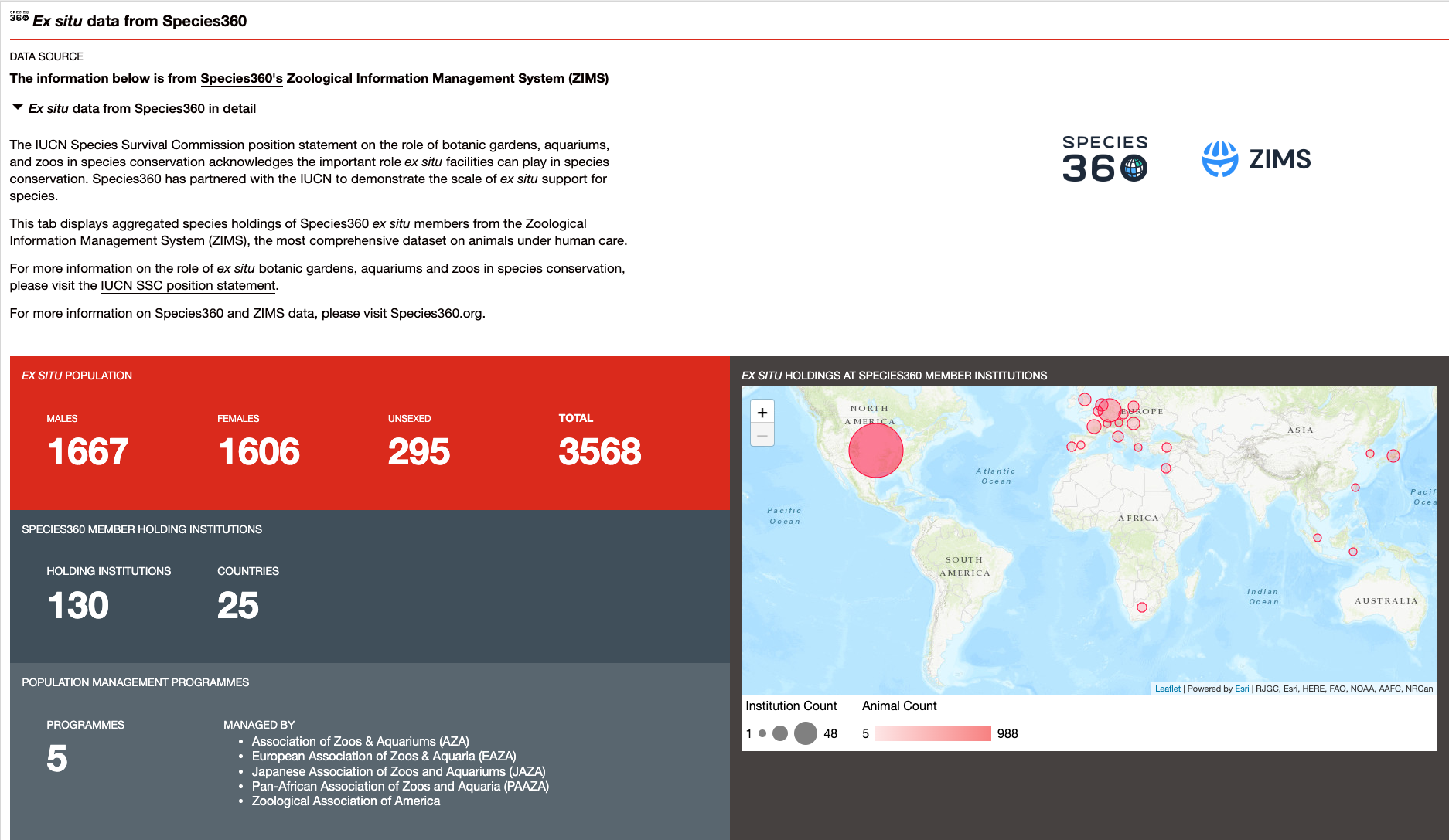Global nonprofit, Species360 announced today that key species population data from its Zoological Information Management System (ZIMS) has been added to the IUCN Red List of Threatened Species. Species360’s ZIMS database, which reflects data recorded and shared by more than 1300 zoo, aquarium, wildlife refuge, and conservation institutions worldwide, is the largest source of data on wildlife in human care.
By integrating Species360 ex situ data into the IUCN Red List of Threatened Species website, the Red List website will now provide a complete image of species population numbers in the wild and in human care.
Also known as the barometer of life, the IUCN Red List is the world’s leading authority on the status of nature in the world. It is the world's most comprehensive information source on the global conservation status of animal, fungi and plant species and a critical indicator of the health of the world's biodiversity. Much like the Red List, Species360’s ZIMS is the world’s most comprehensive database of knowledge on animals in human care, containing millions of records on thousands of species.
This integration is a significant advancement in the "One Plan Approach," which emphasizes the importance of aligning conservation efforts across in situ and ex situ domains to safeguard threatened species.
The IUCN Species Survival Commission position statement on the role of botanic gardens, aquariums, and zoos in species conservation acknowledges the important role ex situ organizations like zoos and aquariums can play in species conservation.

A screenshot from the IUCN Red List of Threatened Species showing the addition of ex situ data from Species360’s Zoological Information Management System (ZIMS).
Chair of the IUCN Species Survival Commission, Jon Paul Rodriguez, said: “There are dozens, perhaps hundreds of examples of species that have recovered from the brink of extinction thanks to populations under human care. Just to name a few, the scimitar-horned oryx was returned to the wild by an international, multi-stakeholder effort led by Environmental Agency Abu Dhabi by drawing on ex situ populations from around the world; Lord Howe Island phasmid ex situ breeding led by Zoos Victoria’s Melbourne Zoo was very successful and this species – once considered extinct – is expected to be reintroduced to the wild soon; Erica verticillata, a South African plant that was extinct in the wild survived in cultivation in gardens around the world for 200 years until being reintroduced. Though preventing declines and bolstering animal, plant and fungi populations in the wild continues to be our ultimate priority, IUCN’s One Plan assures that all individuals of a species, no matter where they are, contribute effectively to their long-term survival.”
Species360 CEO Jim Guenter said: “We are immensely proud to see ex situ data from zoos and aquariums around the world featured in the IUCN Red List of Threatened Species. With over one million species at risk of extinction, the need for a comprehensive overview of the state of the natural world has never been greater. Zoos and aquariums are critical to safeguarding biodiversity through genetically diverse insurance populations, species reintroduction programs, species conservation project support and funding, and public education.”
Ahead of the launch of the ex situ data tab on the IUCN Red List website, Species360 and the IUCN signed a renewed five-year memorandum of understanding (MoU) continuing the impactful relationship. The MoU outlines the two organizations’ commitment to species conservation through the exchange of information on species and populations, which can contribute to a global understanding of species diversity and support conservation efforts.
The zoos, aquariums, wildlife sanctuaries, and conservation institutions that record and share data as members of Species360 make this advance in population insight possible. Every day, staff at these institutions record data on the individual animals in their care. That data, which is aggregated worldwide in ZIMS, provides knowledge not available anywhere else. The integration of in situ and ex situ data paints a broader and more detailed image of the status of the world’s species, helping to inform conservation actions.
-
News
 Belfast Zoo helps to bring Christmas joy to Children’s Hospital 19th December, 2025Belfast Zoo joined the Lord Mayor of Belfast, Councillor Tracy Kelly, on Monday (15th December) to help bring festive cheer to the Royal Belfast Hospital…
Belfast Zoo helps to bring Christmas joy to Children’s Hospital 19th December, 2025Belfast Zoo joined the Lord Mayor of Belfast, Councillor Tracy Kelly, on Monday (15th December) to help bring festive cheer to the Royal Belfast Hospital… -
News
 Colchester Zoological Society welcomes new arrivals 19th December, 2025This December, Colchester Zoological Society (CZS) welcomed some exciting new arrivals! A young male pygmy hippo, Mikolas, from Zoo Dvur Kralove…
Colchester Zoological Society welcomes new arrivals 19th December, 2025This December, Colchester Zoological Society (CZS) welcomed some exciting new arrivals! A young male pygmy hippo, Mikolas, from Zoo Dvur Kralove… -
News
.png?w=100&h=100&zc=1&f=jpeg&hash=8d175f93cde920c5ba23c8ea7f92e55a) Blog: Understanding the human side of zoos 16th December, 2025Why are zoo researchers increasingly looking to social science? Dr Nieky van Veggel explains the significance of understanding the human dimension…
Blog: Understanding the human side of zoos 16th December, 2025Why are zoo researchers increasingly looking to social science? Dr Nieky van Veggel explains the significance of understanding the human dimension…



